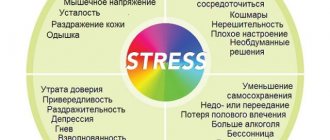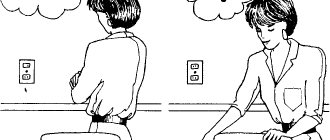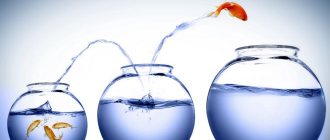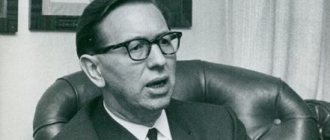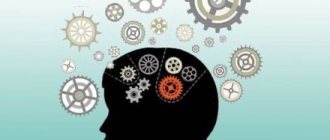Stress
(from the English stress “load, tension; state of increased tension”) - a set of nonspecific adaptive (normal) reactions of the body to the influence of various unfavorable factors-stressors (physical or psychological), disrupting its homeostasis, as well as the corresponding state of the body’s nervous system (or the body as a whole).
In medicine, physiology, and psychology, positive ( eustress
from ancient Greek εὖ- “good”) and negative (
distress
from ancient Greek δυσ “loss”) forms of stress are distinguished. According to the nature of the impact, neuropsychic, heat or cold (temperature), light, hunger and other stresses (irradiation, etc.) are distinguished.
Whatever the stress, “good” or “bad”, emotional or physical (or both), its effect on the body has common non-specific features.
Content
- 1 History of the term
- 2 Physiology of stress 2.1 General adaptation syndrome (GAS)
- 2.2 Adaptive energy
- 2.3 Stress and pharmacology
- 2.4 Further development of stress theory
- 3.1 Eustress
Symptoms
This condition is characterized by an alternating change of stages, which reflect pathological changes in the lungs:
- Stage 1: in the first 6 hours after exposure to the stress factor there are no complaints, clinical changes are not determined.
- Stage 2: after 6-12 hours, increasing shortness of breath, cyanosis, tachycardia develops, a cough with foamy sputum and streaks of blood occurs, and the oxygen content in the blood inexorably drops.
- Stage 3: after 12-24 hours, breathing becomes bubbling, foamy pink sputum is released, hypercapnia and hypoxemia increase, central venous pressure increases, arterial pressure decreases.
- Stage 4: arterial hypotension, atrial fibrillation, severe tachycardia, ventricular tachycardia, thrombocytopenia, leukopenia, pulmonary and gastrointestinal bleeding develop, the level of creatinine and urea increases. The end result is suppression of consciousness and coma.
History of the term
The term “stress” was first introduced into physiology and psychology by Walter Cannon[1] in his classic works on the universal fight-or-flight response[2][3][ 4].
The famous stress researcher, Canadian physiologist Hans Selye, published his first work on the general adaptation syndrome in 1936 [5], but for a long time avoided using the term “stress”, since it was used in many ways to denote “neuropsychic” tension (the “fight or run"). It was not until 1946 that Selye began to systematically use the term "stress" for general adaptive tension.
What is included in the theory of the Canadian physiologist
Selye divided the stress response into three levels:
- If the stress pressure is prolonged, then a level of exhaustion occurs. Adaptation decreases, the body is exposed to diseases. The condition is critical.
- biological;
- emotional.
It is important to note that not all external reactions cause such tension. Only an emotional event can increase certain hormones. Under their influence, the functioning of body systems changes. For example, blood clotting increases and heart rate increases.
In addition, the physiologist Selye identified the types of stress. He divided it into eustress and distress. Eustress usually occurs as a result of a positive event with a high emotional connotation. It serves to preserve as well as maintain life. Distress, on the contrary, is associated with negative mental drama; it is always destructive and has a devastating effect on health. Distress is divided into the following types:
Physiology of stress
General adaptation syndrome (GAS)
Physiological stress was first described by Hans Selye as a general adaptation syndrome. He began to use the term “stress” later.
“Stress is a nonspecific response of the body to any demand presented to it […] In other words, in addition to the specific effect, all agents affecting us also cause a nonspecific need to carry out adaptive functions and thereby restore a normal state. These functions are independent of specific effects. Non-specific demands imposed by the impact itself are the essence of stress
— Hans Selye, “The Stress of Life”[6]
Back in the 1920s, while studying at the University of Prague, Selye drew attention to the fact that the onset of any infection is the same (fever, weakness, loss of appetite). In this generally known fact, he discerned a special property - the universality, non-specificity of the response to any damage. Experiments on rats have shown that they give the same reaction to both poisoning and heat or cold. Other researchers have found a similar reaction in people who have received extensive burns.
Under stress, along with elements of adaptation to strong stimuli, there are elements of tension and even damage. It was the universality of the “triad of changes” that accompanies stress - a decrease in the thymus, an enlargement of the adrenal cortex and the appearance of hemorrhages and even ulcers in the mucous membrane of the gastrointestinal tract - that allowed G. Selye to put forward a hypothesis about the general adaptation syndrome (GAS), which was later called “stress”. The work was published in 1936 in the journal Nature. Many years of research by G. Selye and his colleagues and followers around the world confirm that stress is a nonspecific basis for many diseases.
Selye identified 3 stages of general adaptation syndrome:
- anxiety reaction (mobilization of adaptive capabilities - these capabilities are limited)
- resistance stage
- exhaustion stage
For each stage, characteristic changes in neuroendocrine functioning are described.
Initially, Selye viewed stress solely as a destructive, negative phenomenon, but later Selye writes:
Stress is a nonspecific response of the body to any demand presented to it. […] From the point of view of the stress response, it does not matter whether the situation we are faced with is pleasant or unpleasant. All that matters is the intensity of the need for restructuring or adaptation.
— Hans Selye, “The Stress of Life”[6]
Later, Selye additionally introduced the concept of “positive stress” ( Eustress
), and designated “negative stress” as
distress
.
Adaptive energy
Developing the concept of stress, G. Selye in 1938[7] proposed the concept of short-term and medium-term adaptation (adaptation of adult individuals at times noticeably shorter than life time), based on the concept of adaptive energy.
The concept of adaptation energy allows us to describe individual adaptation differences as differences in the distribution of adaptation energy along the structural and functional scheme of the adaptation system (as well as in the amount of this energy). This scheme itself may be complex, but it is uniform within a given species (to be specific, Selye considers adults of the same sex). In a number of specific physiological experiments, Selye showed that the redistribution of this resource increases resistance to some factors and at the same time reduces resistance to others. The concept of adaptation energy has acquired an “axiomatic” form [8] (quotes mean that these axioms do not provide true axiomatics in the mathematical sense):
- Adaptive energy is available in limited quantities, given from birth.
- There is an upper limit on the amount of adaptive energy that can be used by an individual at any point in (discrete) time. This amount can be concentrated in one direction or distributed among different directions in response to multiple environmental challenges.
- There is a threshold of exposure to an external factor that must be crossed to trigger an adaptive response.
- Adaptive energy can be active at two different levels of competence: the primary level, at which the response is generated in response to a high level of factor, with high costs of adaptive energy, and the secondary level, at which the response is generated at a low level of influence, with low costs of adaptive energy.
In 1952, Goldstone[9] proposed a critique and development of Selye's theory. He complements Selye's laboratory experiments with descriptions of typical clinical cases that confirm this picture. Goldstone argues that this description of adaptation through adaptation energy is extremely useful. At the same time, he refutes the first axiom, according to which adaptive energy is available in limited quantities, given from birth.
Goldstone proposes the concept of a constant production of adaptive energy, which can also be accumulated and stored in limited quantities, and demonstrates that this concept describes Selye's experiments even better than the original idea of constant adaptive capital. He also uses the work of Carrel[10], who studied adaptation to stimuli below the anxiety threshold and showed that such exercises nonspecifically enhance (“awaken”) the general adaptive response, which contradicts Selye’s purely costly concept, the shortcomings of which he later tried to overcome in his concept of eustress.
Goldstone argues that constantly presenting weak negative stimuli are constantly encountered and overcome by ongoing adaptation. The initializing effect of stimuli is to awaken the adaptation system and bring it into a state of readiness for a faster and more effective response. Stronger stimuli may require more adaptive energy expenditure than is produced; then the adaptive reserve is put into action, and if it is used up, then death occurs. There is a maximum possible rate of consumption of adaptive energy, and at this maximum the body cannot cope with any additional stimulus. Describes how one stimulus can influence an individual's ability to adapt to other stimuli; the outcome depends on the specific situation:
- A patient who cannot cope with an illness is able to overcome it after a moderate additional stimulus.
- In the process of adapting to this new stimulus, he may acquire the ability to respond more intensely to all stimuli.
- As a result of exposure to a strong stimulus, the patient may be unable to adapt to the additional strong stimulus.
- If he successfully adapts to the disease, then this adaptation can be destroyed by exposure to a second strong stimulus.
- For some diseases (particularly diseases of adaptation), exposure to a fresh, strong stimulus can overcome the disease. This exposure is always associated with risk, but it can also normalize the functioning of the adaptation system.
Goldstone's axiom.
Adaptive energy can be produced, although its production declines in old age, and it can also be stored in the form of adaptive capital, although the capacity for this capital is limited. If an individual spends his adaptive energy faster than he produces, then he spends his adaptive capital and dies when it is completely exhausted.
Modern models of adaptation and adaptive energy[11] are based on the idea of limiting factors (first proposed in 1828 by K. Spengler and gained fame in application to agrocenoses after the work of von Liebig, 1840) and evolutionary principles of optimality, originating from the works of J.B. S. Haldane. Adaptation is presented as an evolutionarily optimal system for distributing adaptive energy to neutralize the most harmful factors.
Stress and pharmacology
To treat exhaustion of the nervous system (which occurs due to prolonged (chronic) and/or intense stress), nootropic drugs are used. To symptomatically reduce the severity of stress, anxiolytics and tranquilizers are used.
Further development of stress theory
It is shown that stress (as a classic nonspecific reaction in the description of G. Selye) is just one of the reactions that make up the general system of nonspecific adaptive reactions of the body, since the body, as a more sensitive system than its constituent subsystems, reacts to conditions of different strength and quality stimuli that cause fluctuations in homeostasis within, first of all, normal levels, and stress is a reaction to strong stimuli.
The effect of group stress has been described
, manifested in groups and populations under difficult living conditions: in a typical situation, with an increase in the adaptive load, the level of correlations increases, and as a result of successful adaptation, it decreases.
The greatest information about the degree of adaptation of a population to extreme or simply changed conditions is provided by correlations between physiological parameters. Based on the effect, a correlation adaptometry method
[12]. The method is systematically used in monitoring problems[13].
The use of multiple regression has proven the ability to predict stress levels long before it occurs in order to identify individuals (or groups of individuals) who are particularly susceptible to stress. This method allows not only to identify in advance the level of stress resistance of a person, but also to predict with high accuracy the indicators of the level of mental and somatic stress of people under stress [14].
Eustress state
Being in this state, a person experiences a loss of balance. With all this, he has certain resources (material, spiritual, ethical, moral, current experience, knowledge base, etc.) in order to solve the problems assigned to him. Typically, the state of eustress is short-term, during which the “shallow” adaptive reserves of the personality are intensively lost. This is manifested by inconsistencies in conversation (speech gets confused, a person cannot correctly construct and express his thoughts), temporary memory lapses, somatic reactions (short-term darkening of the eyes, a rush of blood to the skin, rapid heartbeat, etc.). But at the same time, the psychological functions of the individual (memory, thinking, imagination) and the physiological functions of the body proceed even better. With eustress, a person feels a rise in internal strength.
Types of stress
Eustress
The concept has two meanings: “stress caused by positive emotions” and “mild stress that mobilizes the body.”
Distress
A negative type of stress that the body cannot cope with. It undermines human health and can lead to serious illnesses. The immune system suffers from stress. People under stress are more likely to become victims of infection, since the production of immune cells drops markedly during periods of physical or mental stress.
Emotional stress
Emotional stress refers to the emotional processes that accompany stress and lead to adverse changes in the body. During stress, the emotional reaction develops earlier than others, activating the autonomic nervous system and its endocrine support. With prolonged or repeated stress, emotional arousal can stagnate, and the functioning of the body can go wrong[15].
Psychological stress
Psychological stress, as a type of stress, is understood differently by different authors, but many authors define it as stress caused by social factors[15].
Signs
Distress in acute psychology is a pathology that is impossible to notice. It is possible to recognize only the chronic form.
It is expressed:
- the appearance of bad habits in a person;
- changes in taste preferences;
- a decrease or, conversely, an increase in appetite;
- change in character;
- loss of interest in favorite activities;
- lack of desire to improve your life, indifference to everything around you;
- disruption of the nervous system, anxiety, insomnia, decreased performance;
- deterioration of the thought process;
- headaches, increased blood pressure, chills, nausea;
- change in speech. The person begins to stutter, swallow phrases, and pronounce words unclearly.
The manifestation of distress is accompanied by 4 main behavior patterns:
- Panic fear - it cannot be explained logically; the individual loses the ability to correctly respond to the current situation.
- Aggression and anger both towards others and towards oneself personally. This behavior makes it difficult to find a compromise.
- The desire to escape reality.
- Obsessing over a problem.
Distress syndrome is one of the main causes of the development of coronary heart disease and hypertension.
Using stress for interrogation or psychological manipulation
A lie detector is a device for checking the veracity of a person’s words. The program of test questions widely uses methods that increase stress in the respondent so that he loses control over his behavior when answering.
“Stress interview,” in personnel work, is a method of questioning in which the interviewer deliberately creates an atmosphere of nervousness and confuses the applicant with unexpected questions.
These methods are well described by the concept of “provocation” (and/or “trolling”).
Shown, for example, in the television series “Lie to Me.”
Respiratory distress syndrome
This is a very severe manifestation of respiratory deficiency, in which hypoxia, non-cardiogenic pulmonary edema, and impaired external breathing develop. As a result of a sharp decrease in ventilation and oxygenation of the body, oxygen deficiency of the brain and heart is observed, which can threaten human life. This reaction can develop due to:
- viral, bacterial, fungal pneumonia;
- sepsis;
- long-lasting and pronounced anaphylactic or septic shock;
- aspiration of water, vomit;
- chest injuries;
- inhalation of toxic and irritating substances (chlorine, ammonia, phosgene, pure oxygen);
- pulmonary embolism;
- venous fluid overload;
- burns;
- autoimmune processes;
- drug overdose.
Notes
- E. Lescouflair
, Walter Bradford Cannon: Experimental Physiologist Archived March 16, 2010, Harvard College, 2003. - Cannon, W. B.
, The wisdom of the body. New York: W. W. Norton, 1932. - J. C. Quick and C. D. Spielberger
, Walter Bradford Cannon: Pioneer of stress research, International Journal of Stress Management, Volume 1, Number 2, April, 1994, 141–143. - Jerry Kennard
, A Brief History of the Term Stress, June 10, 2008 - Selye, H.
A Syndrome Produced by Diverse Nocuous Agents. Nature. vol. 138, July 4 (1936), p. 32. - ↑ 12
Hans Selye, The Stress of Life - Selye H.
, Experimental evidence supporting the conception of “adaptation energy”, Am. J. Physiol. 123 (1938), 758–765. - Schkade JK, Schultz S.
, Occupational adaptation in perspectives. Ch. 7 in: Perspectives in Human Occupation: Participation in Life, By P. Kramer, J. Hinojosa, Ch. Brasic Royeen (eds), Lippincott Williams & Wilkins, Baltimore, MD, 2003, 181-221. - Goldstone B.
, The general practitioner and the general adaptation syndrome, S. Afr. Med. J. 26 (1952), 88-92, 106-109. (The general practitioner is a general practitioner, in Russia it corresponds to a local therapist.) - Carrel A.
, L'Homme, set Inconnu, Paris: Plon, 1935. - P. 261 - Gorban AN, Pokidysheva LI, Smirnova EV, Tyukina TA
, Law of the minimum paradoxes. Bull. Math. Biol. 73(9) (2011), 2013–2044. - Sedov K. R., Gorban A. N., Petushkova E. V., Manchuk V. T., Shalamova E. N.
Correlation adaptometry as a method of medical examination of the population // Bulletin of the USSR Academy of Medical Sciences. - 1988. - No. 10. - P.69-75. - Pokidysheva L.I., Belousova R.A., Smirnova E.V.
Method of correlation adaptometry in assessing the secretory function of the stomach in children in the North // Bulletin of the Russian Academy of Medical Sciences, 1996. - No. 5. - P.42-45 . - Shcherbatykh Yu. V., Esaulenko I. E.
Forecasting and correction of the level of emotional stress among higher school students // System analysis and management in biomedical systems. 2002, T.1, No. 3.- P.319-322. - ↑ 1 2 Tarabrina N.V., Agarkov V.A., Bykhovets Yu.V., Kalmykova E.S., Makarchuk A.V., Padun M.A., Udachina E.G., Khimchyan Z.G. , Shatalova N.E., Shchepina A.I.
Practical guide to the psychology of post-traumatic stress Part 1. Theory and methods / under the general editorship of Tarabrina N.V. - M.: Publishing house "Cogito-Center", 2007. - P. 12-13. — 208 p. — (Psychological tools). — 2000 copies. — ISBN 978-5-89353-208-1.
Links
- [www.glossary.ru/cgi-bin/gl_sch2.cgi?RRywlxx: A group of articles on stress from Glossary.ru]
- [www.zercalo.ru/therapy/selstress1.shtml Hans Selye. "The Stress of Life"]
- [n-life.org/?p=58 A. N. Khatsinsky “How to overcome stress?”]
- [flogiston.ru/library/sokolova-berezin E. D. Sokolova, F. B. Berezin, T. V. Barlas “Emotional stress”] (Sokolova E. D., Berezin F. B., Barlas T. V. "Emotional stress: psychological mechanisms, clinical manifestations, psychotherapy". MateriaMedica. 1996. N 1(9). P. 5-25 (abbreviated))
- [flogiston.ru/library/naenko Naenko N. I. “The nature of mental tension”] (Naenko N. I. “Mental tension”. M., 1976. P. 5-20.)
- [psystatus.ru/partner_article.php?id=117 Stress] in a child
- [www.go-psy.ru/article13.htm Stress] - the costs of frequent word use
Literature
- Kitaev-Smyk L. A. Psychology of stress: psychological anthropology of stress.
- Selye G.
Essays on the adaptation syndrome. - M.: Medgiz, 1960. - 255 p. - Selye G.
Prevention of cardiac necrosis by chemical means. - M: Medgiz, 1961. - 207 p. - Selye G.
At the level of the whole organism. - M: Nauka, 1972. - 122 p. - Selye G.
Stress without distress. - M: Progress, 1979. - 123 p. - Shcherbatykh Yu. V.
Psychology of stress - M.: Eksmo, 2008. - 304 p. - Shcherbatykh Yu. V.
Psychology of stress and correction methods. - St. Petersburg: Peter, 2007. - 256 p. - Allen Elkin.
Stress for dummies = Stress Management For Dummies. - M.: Williams, 2006. - P. 320. - ISBN 0-7645-5144-2-257. - Selye, H.
A Syndrome Produced by Diverse Nocuous Agents. Nature. vol. 138, July 4 (1936), p. 32.
Prerequisites
Distress is a condition that develops as a result of:
- long-term inability to satisfy one’s physiological needs (lack of air, food, water, heat);
- unusual, inappropriate living conditions (for example, forced living in the mountains, where the air concentration differs from normal);
- damage to the body, diseases, injuries, long-term pain;
- long-term negative emotions.


